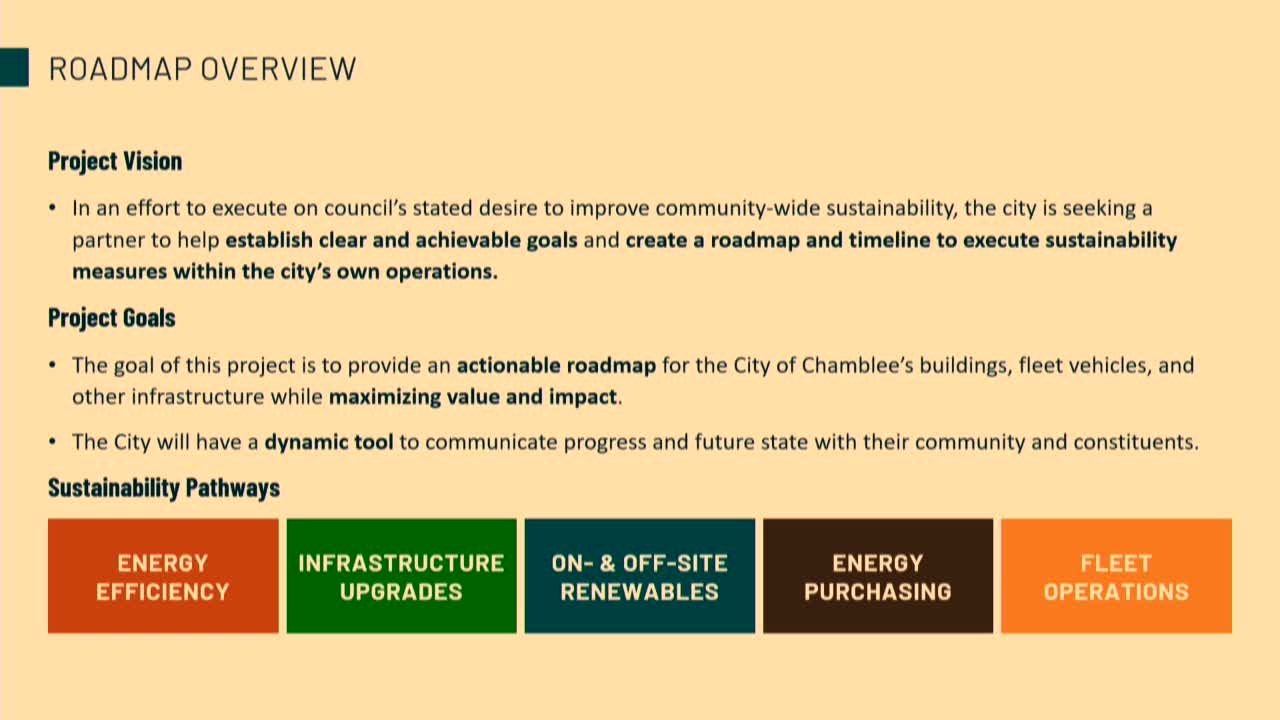City outlines ambitious plan to cut emissions and costs
October 10, 2024 | Chamblee, DeKalb County, Georgia
This article was created by AI summarizing key points discussed. AI makes mistakes, so for full details and context, please refer to the video of the full meeting. Please report any errors so we can fix them. Report an error »

In a recent government meeting, city officials discussed a comprehensive roadmap aimed at reducing emissions from municipal facilities and fleet operations. The focus was on establishing achievable sustainability goals while ensuring fiscal responsibility and community visibility.
The meeting highlighted the city's current emissions profile, revealing that approximately 68% of emissions stem from fuel usage, with electricity contributing 29% and natural gas a mere 3%. City Hall was noted as a leading example of sustainability, being fully electrified, while public safety operations were identified as the largest consumers of fuel.
Key guiding principles for the sustainability initiative were outlined, emphasizing high integrity, actionable steps, fiscal responsibility, and the use of proven technologies. Officials stressed the importance of creating visible impacts for the community to foster engagement and support.
The proposed strategy includes three core components: improving efficiency, transitioning to electrification, and investing in on-site renewable energy sources, particularly solar power. The Inflation Reduction Act was cited as a significant factor in making solar investments more financially viable for the city.
The roadmap anticipates a total investment of approximately $15.3 million, with projected lifetime savings of around $9 million. The plan aims for a 35% reduction in CO2 emissions by 2029, primarily through efficiency upgrades and electrification of the fleet. However, the transition of the public safety fleet to electric vehicles remains a critical factor in achieving more substantial emissions reductions.
The phased approach to implementing these initiatives is set to begin in 2025, with the goal of generating 54% of the city's electricity needs through on-site solar by 2028. The meeting concluded with a commitment to transparency and ongoing community engagement as the city moves forward with these sustainability efforts.
The meeting highlighted the city's current emissions profile, revealing that approximately 68% of emissions stem from fuel usage, with electricity contributing 29% and natural gas a mere 3%. City Hall was noted as a leading example of sustainability, being fully electrified, while public safety operations were identified as the largest consumers of fuel.
Key guiding principles for the sustainability initiative were outlined, emphasizing high integrity, actionable steps, fiscal responsibility, and the use of proven technologies. Officials stressed the importance of creating visible impacts for the community to foster engagement and support.
The proposed strategy includes three core components: improving efficiency, transitioning to electrification, and investing in on-site renewable energy sources, particularly solar power. The Inflation Reduction Act was cited as a significant factor in making solar investments more financially viable for the city.
The roadmap anticipates a total investment of approximately $15.3 million, with projected lifetime savings of around $9 million. The plan aims for a 35% reduction in CO2 emissions by 2029, primarily through efficiency upgrades and electrification of the fleet. However, the transition of the public safety fleet to electric vehicles remains a critical factor in achieving more substantial emissions reductions.
The phased approach to implementing these initiatives is set to begin in 2025, with the goal of generating 54% of the city's electricity needs through on-site solar by 2028. The meeting concluded with a commitment to transparency and ongoing community engagement as the city moves forward with these sustainability efforts.
View full meeting
This article is based on a recent meeting—watch the full video and explore the complete transcript for deeper insights into the discussion.
View full meeting
